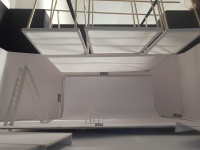Love and Information: Difference between revisions
| Line 79: | Line 79: | ||
===Camera Render=== | ===Camera Render=== | ||
Using the camera render tool in Vectoroworks, we can get an approximate idea of sightlines and what audiences will be looking at from specific places in the venue. | Using the camera render tool in Vectoroworks, we can get an approximate idea of sightlines and what audiences will be looking at from specific places in the venue. | ||
<gallery mode="slideshow"> | |||
File:1 - L&I_Camera_Render_1.png|Seating Bank | |||
File:1 - L&I_Camera_Render_2.png|Overhead | |||
File:1 - L&I_Camera_Render_3.png|Seating Bank Alt. | |||
==Stage Management== | ==Stage Management== | ||
Revision as of 12:49, 4 June 2020
| Love and Information | ||||||||||||||||||||||||||||||
|---|---|---|---|---|---|---|---|---|---|---|---|---|---|---|---|---|---|---|---|---|---|---|---|---|---|---|---|---|---|---|

| ||||||||||||||||||||||||||||||
Overview
Technical Stage Department
The technical stage department had three main scenic elements that were the bulk of prep, fit-up and production consideration. These elements were: A large BP screen, four light boxes hung at an angle, and a cloth hung from a steel box frame down onto the floor which thrust into the playing space.
The BP Screen
A priority of the design was for the venue to be entirely white. Initially, white masking on the Chandler tab system had been requested in order to produce that effect. The stage department immediately recognised that using the white masking in stock would not be adequate. As such, a plan collaborating the LX design, design, and stage departments needs manifested into a discussion about back-projecting onto a screen hung at tab track height behind and around the scenery. This way, the colour of the set would be manipulatable by the LX department and provide a wider scope of colour to the set.
The RCS already had a 15Mx8M BP screen that had a defect in its conduit pocket and had been stored away having never been used. In contact with the BP Screen Company, Harkness, we arranged for this BP screen to be sent to their shop and cut in two at the dimension of 15Mx3.8M, the height of the Chandler Tab Track. This way, the department cut a large sum of money from the cost of a new BP screen and added two BP screens to the Chandler stock.
The BP screen would have hung from a 6M scaff bar joined to two 3M curved scaff bars with scaff joiners. This bar configuration would be hung on drifts that went to cross bars directly above. Floods would be placed behind the screen and back-light onto it.
Light Boxes
The light boxes were four hung steel boxes with white muslin stretched across their face. The scenic effect intended to have light diffuse through the screens.
Originally, the light boxes were one large box. After raising concerns about rigging points and the build of the structure, the design was changed to four separate trapezoid boxes, one large one in the back, for smaller ones in-front. The boxes would hang from an angle that ascended towards the ceiling.
With flying irons built into the frame of the boxes, nylon cord would be tied to the boxes and suspend them from cross bars overhead. Nylon cord was decided upon because the number of points needed was more than we could supplement from stock, the boxes would need to be regularly accessed and shifted in order to focus lights above it, and the angles of the boxes would be easier to manipulate using cord. A concern with using cord was its susceptibility to melting under heat. With lights in close proximity to the cord, discussions were had as to how to avoid direct heat from hitting the lines. We decided that the cords would be far enough from heat exposure cast from lights that they would be safe to use.
Photography Cloth
The cloth that was both hung and on the playing space would have been hung from a steel box frame with ties and curve onto the floor. The cloth would have been a bespoke cut as it became wider as it became longer. In order to produce a sufficient curve in the cloth as it transitioned from air to floor, a considerable amount of tension would have to have been pulled into the cloth. This, as well as actor movement on the cloth, meant that staples were unlikely to be sufficient and a plan to screw strips of wood into the floor that would overlay the sides of the cloth was devised. Cast would also have been instructed as to the limit of their movement on the cloth. The frame would have been screwed into the floor at base plates.
Further Considerations
In order to best achieve the look of an entirely white set, the venue would have had to be painted white. A sacrificial floor would have been lain in order to transition to the next show in as little time as possible. The walls and other parts of the venue would have still needed painting and would have been done before the fit-up date.
12 pieces of steel deck would have been placed side on in the venue serving as a seating bank, and had a centre aisle in the middle for audience egress. The deck went from 200MM to 400MM high and would have had a tread access and handrails to prevent falls and aid in egress and descent from the platform. A seating capacity of 88 was reached with this configuration.
The turn-around time from this show into the next show, Enron, was very short and required the set from Love and Information to be stricken in a morning. With the sacrificial floor, a cleared out dedicated space for stricken scenery to be stored, and equipment being used across both shows, it was theoretically possible.
Camera Render
Using the camera render tool in Vectoroworks, we can get an approximate idea of sightlines and what audiences will be looking at from specific places in the venue.
Sound Department
AV Department
.

























